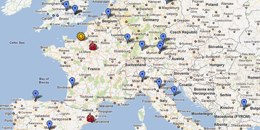
Scientific American Oct 1953 - Evolution in Bacteria
DIYbio aims to be “the institution for the amateur,” developing and providing access to all of the resources a professional might have and an amateur might want, such as equipment, protocols, access to literature, etc. And we are collectively doing so in a distributed fashion right now.
But we are also doing something more, something that will occur slowly, over long time-scales. We are helping lay the foundations for cultural shift. We are laying the foundations for broad, deep, domestic understanding of science and technology.
We are proving that the cultural barriers to practice science in general, and biotechnology in particular, are imaginary. We are proving this by doing it ourselves. We are building a familiarity with the practice and product of science and slowly demonstrating that it can be a cultural activity like musicianship or cooking or solving sudoku puzzles. We are domesticating biotechnology.
As Sophia Roosth recently pointed out, we are proving that “the biological is not something cordoned-off in labs, but something quotidian, personal, and apprehensible,” that we are “intentionally destabilizing what it means to ‘do science’.”
Why is the domestication of biotechnology important? Listen to how W. Brian Arthur begins his recent book, The Nature of Technology:
We are attuned in the deepest parts of our being to nature, to our original surroundings and our original condition as humankind. We have a familiarity with nature, a reliance on it that comes from three million years of at-homeness with it. We trust nature.
When we happen upon a technology such as stemcell regenerative therapy, we experience hope. But we also immediately ask how natural this technology is. And so we are caught between two huge and unconscious forces: Our deepest hope as humans lies in technology; but our deepest trust lies in nature. These forces are like tectonic plates grinding inexorably into each other in one long, slow collision.
The collision is not new, but more than anything else it is defining our era. Technology is steadily creating the dominant issues and upheavals of our time. We are moving from an era where machines enhanced the natural—speeded our movements, saved our sweat, stitched our clothing—to one that brings in technologies that resemble or replace the natural—genetic engineering, artificial intelligence, medical devices implanted in our bodies. As we learn to use these technologies, we are moving from using nature to intervening directly within nature. And so the story of this century will be about the clash between what technology offers and what we feel comfortable with.
By domesticating biotechnology, we are helping society temper its natural mistrust of technology.
DIYbio is just one stone in this cultural foundation, set next to other DIY communities and Citizen Science projects and part of the broader resurgence of DIY culture championed by publications such as MAKE, President Obama, and perhaps the forebears of the internet itself.









One Comment
Post a commentTrackbacks & Pingbacks